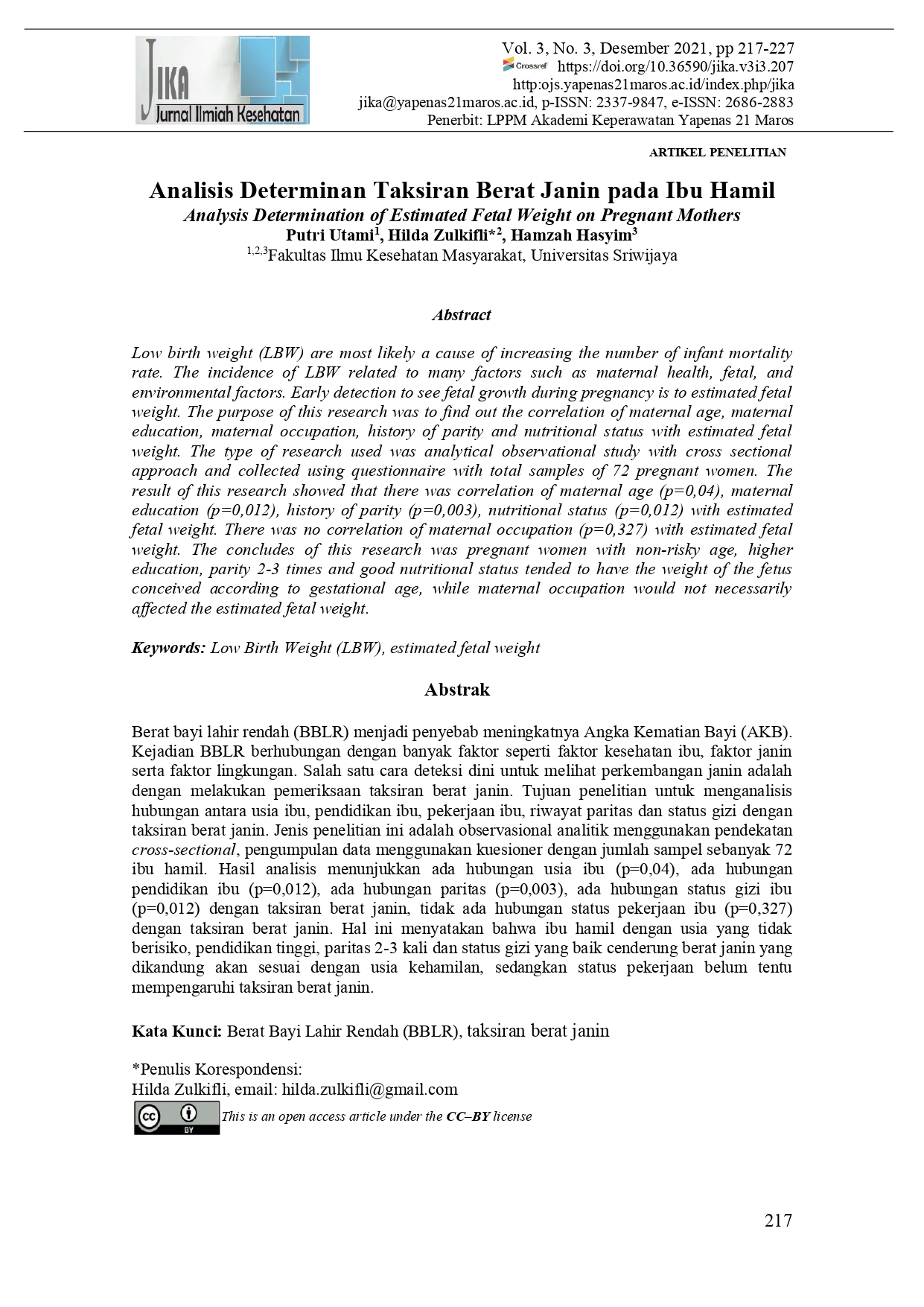Analysis Determination of Estimated Fetal Weight on Pregnant Mothers
DOI:
https://doi.org/10.36590/jika.v3i3.207Keywords:
Low Birth Weight (LBW), Estimated Fetal WeightAbstract
Low birth weight (LBW) are most likely a cause of increasing the number of infant mortality rate. The incidence of LBW related to many factors such as maternal health, fetal, and environmental factors. Early detection to see fetal growth during pregnancy is to estimated fetal weight. The purpose of this research was to find out the correlation of maternal age, maternal education, maternal occupation, history of parity and nutritional status with estimated fetal weight. The type of research used was analytical observational study with cross sectional approach and collected using questionnaire with total samples of 72 pregnant women. The result of this research showed that there was correlation of maternal age (p=0,04), maternal education (p=0,012), history of parity (p=0,003), nutritional status (p=0,012) with estimated fetal weight. There was no correlation of maternal occupation (p=0,327) with estimated fetal weight. The concludes of this research was pregnant women with non-risky age, higher education, parity 2-3 times and good nutritional status tended to have the weight of the fetus conceived according to gestational age, while maternal occupation would not necessarily affected the estimated fetal weight.
Downloads
References
Agho KE, Inder KJ, Bowe SJ, Jacobs J. Dibley M. 2009. Prevalence and Risk Factors for Stunting and Severe Stunting among Under-fives in North Maluku Province of Indonesia. BMC Pediatrics. 9(1): 1-10.
Dinas Kesehatan Provinsi Bengkulu. 2021. Profil Kesehatan Provinsi Bengkulu 2020.
Koullali B., Van Zijl MD, Kazemier BM, Oudijk MA, Mol BW, Pajkrt E, Ravelli A. 2020. The Association between Parity and Spontaneous Preterm Birth: A Population Based Study. BMC Pregnancy Childbirth. 20(1): 1-8.
Kurdanti W, Khasana TM. Wayansari L. 2020. Lingkar Lengan Atas, Indeks Massa Tubuh, dan Tinggi Fundus Ibu Hamil sebagai Prediktor Berat Badan Lahir. Jurnal Gizi Klinik Indonesia. 16(4): 168-175.
Lwanga S, Lemenshow S. 1997. Sample Size Determinations in Health Study: A Practical Manual.
Mahayana SAS, Chundrayetti E, Yulistini Y. 2015. Faktor Risiko yang Berpengaruh terhadap Kejadian Berat Badan Lahir Rendah di RSUP Dr. M. Djamil Padang. Jurnal Kesehatan Andalas. 4(3).
Mardeyanti M, Djulaeha E, Fatimah F. 2013. Ketepatan Taksiran Berat Badan Janin Dibandingkan Dengan Berat Badan Bayi Baru Lahir. Jurnal Ilmu dan Teknologi Kesehatan. 1(1): 12-17.
Noviana F, Siswosudarmo R, Hadiati DR. 2016. Accuracy of Risanto's Formula Compared With Johnson's To Estimate Fetal Weight In Overweight Mothers. Jurnal Kesehatan Reproduksi. 3(1): 8-13.
Okubo H, Miyake Y, Sasaki S, Tanaka K, Murakami K, Hirota Y. 2012. Maternal Dietary Patterns in Pregnancy and Fetal Growth in Japan: The Osaka Maternal and Child Health Study. British journal of Nutrition. 107(10): 1526-1533.
Permana P, Wijaya GBR. 2019. Analisis Faktor Risiko Bayi Berat Badan Lahir Rendah (BBLR) di Unit Pelayanan Terpadu (UPT) Kesehatan Masyarakat (Kesmas) Gianyar I tahun 2016-2017. Intisari Sains Medis. 10(3): 674-678.
Puspita AL, Arifiandi MD, Wardani DS. 2019. Perbandingan Rumus Johnson-Toshack Dan Rumus Risanto Dalam Menentukan Taksiran Berat Janin (TBJ) di Praktek Bidan Delima Yeni Malang. Journal of Issues in Midwifery. 3(2): 48-55.
Rini SS, Windiani I. 2015. Faktor-Faktor Risiko Kejadian Berat Bayi Lahir Rendah di Wilayah Kerja Unit Pelayanan Terpadu Kesmas Gianyar II. OJS Universitas Udayana. 4(4): 1-17.
Rukmana SC, Kartasurya MI. 2014. Hubungan Asupan Gizi dan Status Gizi Ibu Hamil Trimester III dengan Berat Badan Lahir Bayi di Wilayah Kerja Puskesmas Suruh. Journal of Nutrition College. 192-199.
Septiani M, Ulfa M. 2018. Faktor-Faktor yang Berhubungan dengan Kejadian BBLR di Wilayah Kerja Puskesmas Peudada Kabupaten Bireuen. Journal of Health Care Technology. 4(2): 258-275.
Sharma M, Mishra S. 2014. Effects of Maternal Health and Nutrition on Birth Weight of Infant. International Journal of Science Research. 3(6): 855-858.
Silvestrin S, Silva CH, Hirakata VN, Goldani AA, Silveira PP, Goldani MZ. 2013. Maternal Education level and Low Birth Weight: A Meta-Analysis. Journal Pediatric. 89(4): 339-345.
Sumarni R, Ikhsan M. 2014. Hubungan pengetahuan dan Sikap Ibu Hamil tentang Tanda Bahaya Kehamilan, Persalinan dan Nifas trehadap Perilaku ANC Puskesmas Latambaga Kabupaten Kolaka. Jurnal Media Kesehatan Masyarakat Indonesia. 200-220.
Suwarni Y, Noor MS, Rahayu A. 2015. Hubungan antara Paritas, LiLa, Kadar HB dan Usia Ibu Hamil dengan Berat Lahir Bayi. Jurnal Publikasi Kesehatan Masyarakat Indonesia. 1(1): 60-66.
Syahraeni EKA. 2013. Pengaruh Paritas dan Faktor-Faktor Lain Terhadap Kejadian Bayi Berat Lahir Rendah di RS Benyamin Guluh Kabupaten Kolaka Provinsi Sulawesi Tenggara Tahun 2011-2012. Program Studi Kebidanan Komunitas FKM UI. Departemen Gizi FKM UI.
Widatiningsih S, Hastuti TP. Wibowo MT. 2015. Akurasi Penaksiran Berat Janin menggunakan Metode Johnson pada Ibu Hamil Trimester III di Wilayah Kerja Puskesmas Pare Kabupaten. Jurnal Riset Kesehatan. 4(2): 743-747.

Downloads
Published
How to Cite
Issue
Section
License
Copyright (c) 2021 Putri Utami, Hilda Zulkifli, Hamzah Hasyim

This work is licensed under a Creative Commons Attribution 4.0 International License.








